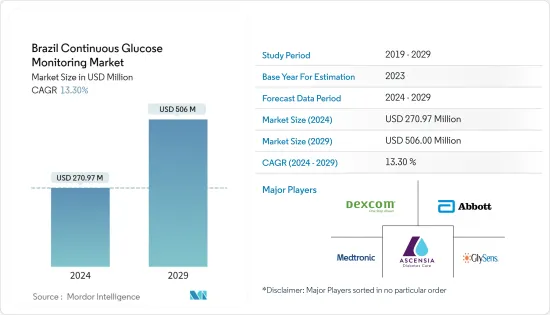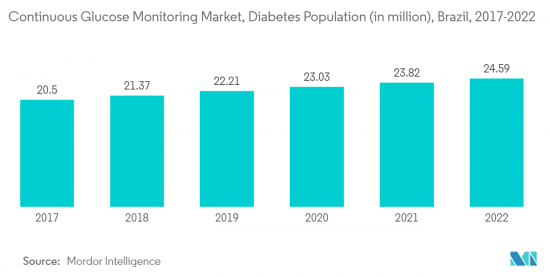PUBLISHER: Mordor Intelligence | PRODUCT CODE: 1408317

PUBLISHER: Mordor Intelligence | PRODUCT CODE: 1408317
Brazil Continuous Glucose Monitoring - Market Share Analysis, Industry Trends & Statistics, Growth Forecasts 2024 - 2029

The Brazil Continuous Glucose Monitoring Market size is estimated at USD 270.97 million in 2024, and is expected to reach USD 506 million by 2029, growing at a CAGR of 13.30% during the forecast period (2024-2029).
People with chronic diseases such as diabetes mellitus and obesity had a worse prognosis of COVID-19. The Brazilian federal, state, and municipal authorities broadened the measures to reach more people to quickly improve the response and prevent a surge of individuals with diabetes infected by SARS-CoV-2 and acute and chronic diabetes complications.
Diabetic people were twice as likely to have their comorbid conditions worsened and consequently to die. The prevalence of diabetes in people hospitalized with COVID-19 infection and the recognition that improved glycemic control might improve outcomes and reduce the length of stay in patients with COVID-19 underlined the importance of diabetes devices such as continuous glucose monitoring devices.
Continuous glucose monitoring observes patterns in the fluctuation of blood glucose levels that occur in response to diet, exercise, medications, and or pathological processes associated with blood glucose fluctuations, such as diabetes. Unusually high or low blood glucose levels can potentially lead to acute and or chronic, life-threatening conditions. Managing diabetes to improve patient outcomes requires a complex multidisciplinary approach. Appropriate and timely monitoring of blood glucose allows the successful management of out-of-range blood glucose levels, minimizing diabetic-related health complications.
Brazil has implemented a set of reforms to improve the distribution of doctors, develop new forms of service organization, introduce new financing models, and implement a range of quality improvement initiatives and policy frameworks to overcome risk factors such as obesity. The Federal Government of Brazil partnered with numerous private companies to utilize their supply chain primarily to ensure low prices for devices, which is likely to drive market growth during the forecast period.
Brazil Continuous Glucose Monitoring Market Trends
Rising Diabetes Prevalence in Brazil is anticipated to boost the market studied
In Brazil, the diabetes population is expected to increase with a CAGR of about 2.9% over the forecast period.
According to IDF Diabetes Atlas 2021, 15.7 million adults, about 10.5%, were living with diabetes in Brazil. The cost of diabetes-related health expenditure in Brazil is the third highest in the world, at 42.9 billion USD. In addition, 18 million adults, around 11.9%, have impaired glucose tolerance, which places them at high risk of developing type 2 diabetes. Diabetes is associated with many health complications. Comparing the population with and without diabetes, those with diabetes have an increased risk of being hospitalized and, thus, incur more healthcare expenses compared to non-diabetic people. Additional data on glycaemic control in Brazil show that only 25% met the therapeutic goal of glycated hemoglobin < 7% before the pandemic, as recommended by the Brazilian Diabetes Society (SBD).
The high prevalence of diabetes is associated with a significant economic burden. The costs of diabetes are increased in patients with co-morbidities such as hypertension and hyperlipidemia and in patients who develop complications. Costs increase with an increasing number of complications. The Ministry of Health established a list of medications and supplies provided by the Brazilian Health System to patients suffering from diabetes. However, their supply is usually not sufficient or recommended for optimal patient management across cities. In Brazil, the public health system Sistema Unico de Saude has been progressively increasing the assistance available for individuals with diabetes.
Therefore, owing to the increasing diabetes prevalence and aforementioned factors, the studied market is anticipated to witness growth over the analysis period.

The Sensors Segment is Expected to Hold the Highest Share Over the Forecast Period
The sensors segment is expected to register a CAGR of 16.9% over the forecast period.
To perform continuous glucose monitoring (CGM), a small sensor is inserted into the abdomen or arm with a tiny plastic tube known as a cannula penetrating the top layer of skin. An adhesive patch holds the sensor in place to take glucose readings in interstitial fluid throughout the day. Generally, the sensors must be replaced every 7 to 14 days. A small, reusable transmitter connected to the sensor allows the system to send real-time readings wirelessly to a monitor device that displays blood glucose data. Some systems come with a dedicated monitor, and some display the information via a smartphone app.
CGM sensors have proven to be effective for patients with frequent hypoglycemic events, sensor-augmented pumps, and gestational diabetes, treated with either continuous subcutaneous insulin infusion or a multiple daily injections insulin regimen. Researchers are trying to find and develop alternatives to electrochemical-based glucose sensors and create more affordable, minimally invasive, and user-friendly CGM sensors. Optical measurement is a promising platform for glucose sensing. Some technologies have been reported with high potential in continuous glucose sensing, including spectroscopy, fluorescence, holographic technology, etc. Eversense, a CGM sensor based on fluorescence sensing developed by Senseonics company, presents a much longer lifespan in comparison with electrochemical sensors.
It is imperative that CGM devices be used alongside insulin pumps. As the trends show a higher number of diabetic patients using insulin pumps for diabetes management, it can be predicted that the number of units of CGM devices sold will also follow. Type-1 diabetic patients require continuous monitoring to keep a close watch on their glucose levels, which is likely to generate demand in the coming years. Due to the adaptability of new technology and the high prevalence of diabetes population, the market studied is expected to grow.
Brazil Continuous Glucose Monitoring Industry Overview
The Brazil continuous glucose monitoring market is consolidated, with few significant players. There have been constant innovations driven by manufacturers such as Abbott, Dexcom, Medtronic, etc., while also adhering to organic growth strategies, which is evident from the R&D spending of these companies.
Additional Benefits:
- The market estimate (ME) sheet in Excel format
- 3 months of analyst support
TABLE OF CONTENTS
1 INTRODUCTION
- 1.1 Study Assumptions and Market Definition
- 1.2 Scope of the Study
2 RESEARCH METHODOLOGY
3 EXECUTIVE SUMMARY
4 MARKET DYNAMICS
- 4.1 Market Overview
- 4.2 Market Drivers
- 4.3 Market Restraints
- 4.4 Porter's Five Forces Analysis
- 4.4.1 Bargaining Power of Suppliers
- 4.4.2 Bargaining Power of Consumers
- 4.4.3 Threat of New Entrants
- 4.4.4 Threat of Substitute Products
- 4.4.5 Intensity of Competitive Rivalry
5 MARKET SEGMENTATION
- 5.1 Component
- 5.1.1 Sensors
- 5.1.2 Durables
6 MARKET INDICATORS
- 6.1 Type-1 Diabetes Population
- 6.2 Type-2 Diabetes Population
7 COMPETITIVE LANDSCAPE
- 7.1 Company Profiles
- 7.1.1 Abbott Diabetes Care
- 7.1.2 Dexcom Inc.
- 7.1.3 Medtronic PLC
- 7.1.4 Ascensia Diabetes Care
- 7.1.5 GlySens
- 7.2 Company Share Analysis
- 7.2.1 Abbott Diabetes Care
- 7.2.2 Dexcom Inc.
- 7.2.3 Medtronic PLC
- 7.2.4 Others
8 MARKET OPPORTUNITIES AND FUTURE TRENDS




